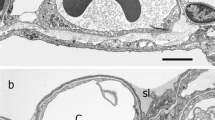Abstract
The increasing application of computers in clinical lung laboratories requires formulas for the calculation of spirometric predicted values. Formulas need much less storage capacity than large tables with predicted values.
The predicted values of CARA for vital capacity, forced expiratory volume, and residual volume are derived from a large number of subjects and take into account age and height. These tables are used for calculating formulas. All three parameters show a close correlation with the third power of height. Vital capacity and forced exspiratory volume correlate with the square of age, residual volume directly with age. The given formulas are valid with a standard error of≦52 ml for men with a height ranging from 1.50 to 1.95 m and age of 18 to 79 years.
Zusammenfassung
Die zunehmende Verwendung von Computern in klinischen Laboratorien für Lungenfunktionsuntersuchungen erfordert Formeln, aus denen spirometrische Sollwerte berechnet werden können. Formeln benötigen wesentlich weniger Speicherkapazität als Sollwerttabellen. Die Sollwerte für die Vitalkapazität, den Atemstoß und das Residualvolumen nach CARA, die die Körpergröße und das Lebensalter berücksichtigen, beruhen auf dem größten Probandengut und werden für die Aufstellung von Gleichungen benutzt. Es ergibt sich für alle drei Größen eine enge Korrelation zur 3. Potenz der Körpergröße. Die Vitalkapazität und der Atemstoß korrelieren mit dem Quadrat des Lebensalters, das Residualvolumen direkt mit dem Lebensalter. Die aufgestellten Formeln gelten mit einer Standardabweichung≦52 ml für Männer mit einer Körpergröße von 1,50–1,95 m und einem Lebensalter von 18–79 Jahren.
Similar content being viewed by others
Literatur
Amrein, R., Keller, R., Joos, H., Herzog, H.: Neue Normalwerte für die Lungenfunktionsprüfung mit der Ganzkörperplethysmographie. Dtsch. med. Wschr.94, 1785–1793 (1969).
Anderson, T. W., Brown, J. R., Hall, J. W., Shephard, R. J.: The limitations of linear regressions for the prediction of vital capacity and forced expiratory volume. Respiration25, 140–156 (1968).
Anthony, A. J.: Untersuchungen über Lungenvolumina und Lungenventilation. Dtsch. Arch. klin. Med.167, 120–129 (1930).
Baldwin, E. F., Cournand, A., Richards, D. W. Jr.: Pulmonary insufficiency: I. Methods of analysis, physiologic classification, standard values in normal subjects. Medicine (Baltimore)27, 243–278 (1948).
Cara, M.: Leitfaden für die praktische Durchführung der Untersuchung der ventilatorischen Funktion durch die Spirographie. Luxemburg. Schriftenreihe Arbeitshygiene und Arbeitsmedizin der Europäischen Gemeinschaft für Kohle und Stahl, Nr. 2, 1961. Neuauflage (im Druck).
Hutchinson, J.: On the capacity of the lung and on the respiratory functions with a view of establishing a precise and easy method of detecting disease by the spirometer. Trans. med. chir. Soc. Edinb.29, 137–158 (1848).
West, H. F.: Clinical studies on the respiration VI: Comparison of various standards for the normal vital capacity of the lungs. Arch. intern. Med.25, 306–327 (1920).
Author information
Authors and Affiliations
Additional information
Mit finanzieller Unterstützung der Europäischen Gemeinschaft für Kohle und Stahl, Luxemburg.
Rights and permissions
About this article
Cite this article
Smidt, U., Muysers, K. & v. Nieding, G. Nichtlineare Formeln zur Berechnung spirometrischer Sollwerte. Pneumonologie 144, 52–58 (1971). https://doi.org/10.1007/BF02102198
Received:
Issue Date:
DOI: https://doi.org/10.1007/BF02102198




